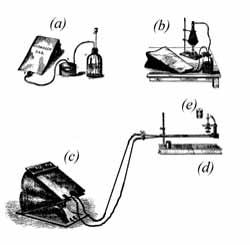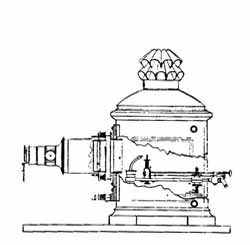![]()
HISTORY OF BINGHAM
Limelight
The 1870s saw the invention of the first electric lamps; the carbon arc and later the Swan’s carbon filament lamp. In order to light them it was necessary to have either a steam engine to run the recently invented electric generators or a room full of batteries! Even then the carbon arc needed constant attention if the arc was to be held at the optical centre of the projector and it would be several more decades before filament lamps were bright enough for this job. Bingham did have gas from 1853 but gaslights only had bare flames, which were unsteady and very low brightness. Mantles that did increase the brightness significantly were not available until the early 1900s. Thus the only practical light source to project magic lantern slides in the 1870s was limelight.
So, when the Rev. Robert Miles wanted to hold a magic lantern show, that is what he had to use. It provided a high brightness source by heating a block of quicklime (calcium oxide) to incandescence. As gas in cylinders was not available, it was necessary to fill two bags before the show, one with oxygen and the other with hydrogen. This was a fairly slow process. The bags were then placed between hinged, weighted boards to keep the gas under reasonably constant pressure. The tap on each bag was then connected with rubber tubing to the two burners on the limelight apparatus. The taps were then turned on and a match applied to gas jets directed onto the block of quicklime. This block then had to be rotated manually by the operator, in between changing slides, to keep it evenly heated.

The equipment required to operate
limelight: (a) and (b) filling the gas bags with hydrogen and oxygen;
(c) set of double weighted boards to maintain the gas pressure through
the rubber tubing connected to (d) the limelight burner; (e) the
block of quicklime is mounted on the vertical rotatable spindle
in line with the two gas jets.

A typical magic lantern projector
from the 1860s. The cut-away shows the limelight apparatus mounted
in the optical system. The mechanism to rotate the block of quicklime
has been brought out at the rear of the housing with the gas connections.
